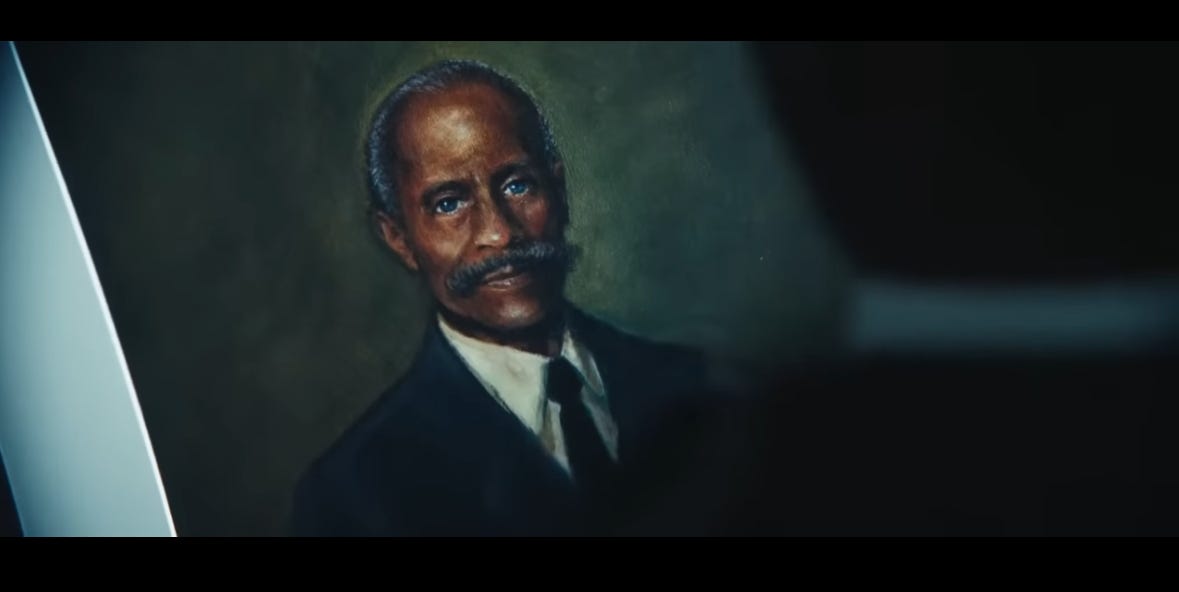‘Severance’ Challenges Corporate America’s Cynical Representation
About that Black Kier Eagan painting
Lumon Industries, the sinister corporation (or just “corporation”) from Severance, has promoted Seth Milchick (Tramell Tillman) to manager of the horror show they’re running in the basement. In the second season’s third episode, “Who Is Alive?,” Lumon “rewards” him with a bizarre gift.
Natalie (Sydney Cole Alexander), the unsettling PR representative, tells Milchick the mysterious unseen “board is jubilant at your ascendance” and “wants you to feel appreciated.” So, she presents Milchick with paintings of Kier Eagan, Lumon’s founder and cult leader, which have been altered so that Kier is now Black, just like Milchick. (Watch below.)
Billy Fellows at Collider wrote that the paintings were “the most detestable side of Lumon we’ve seen yet,” while acknowledging that Lumon actively tortures its employees. That seems worse. In fact, the painting scene begins with an annoyed Milchick collecting balloons with Mark’s (Adam Scott) face on them. He’d given them to Mark to distract from his barrage of lies and cruel manipulation. Milchick poses as an ally but he’s actively conspiring to keep a part of Mark imprisoned forever.
The “Black Kier Eagan” paintings are clueless and offensive, but so is a lot of clumsy, cloying identity-based corporate liberalism in the real world. Natalie tells Milchick that the paintings have been “inclusively re-canonicalized” and “intended to help you see yourself in Kier, our founder.” This is verbiage that real-life Natalies pick up in corporate DEI training and earnestly repeat as if it means something.
Natalie, who’s also Black, is Lumon’s (incredibly) attractive public face, defending the company in often contentious news interviews while never dropping her creepily pleasant facade. However, Lumon’s top executives are all white. It’s a classic example of strategic diversity.
Is this blackface?
The Collider review is not alone in describing the “inclusively re-canonicalized” paintings as “blackface.” Blackface traces back to the early 19th Century minstrel shows, where white performers would darken their skin and portray racist caricatures of Black people, who were depicted as dimwitted, shiftless buffoons who were nonetheless “happy-go-lucky” despite their subhuman legal status.
Frederick Douglass publicly called blackface performers “the filthy scum of white society” in 1848. This brother was fearless. “[They] have stolen from us a complexion denied to them by nature ... to make money and pander to the corrupt taste of their white fellow-citizens.”
However, “Black Kier Eagan” is a lot like those Black Jesus paintings — a figure of worship depicted in a more “inclusive” manner. (Yes, I realize there’s much debate over Jesus’s appearance. I’m not Megyn Kelly.) “Black Kier Eagan” is still rendered as an attractive man. Blackface historically presented Black features as grotesque with bulging eyes and cartoonishly large lips. Even Black minstrel performers had to darken their skin with coal.
White actor Thomas D. Race claims to have modeled his minstrel character “Jim Crow” after an enslaved man. He spoke in a mocking imitation of Black dialect and sang such “Negro ditties” as “Jump Jim Crow.” (Watch below.)
Adding further insult to injury, “Jim Crow” would later become shorthand for laws enforcing racial segregation. White people had thus created the distorted image of the Black people they oppressed.
Blackface was intended to amuse a white audience while reinforcing their unwarranted superiority over Black people. The “Black Kier Eagan” paintings are performative diversity, intended to placate Black employees. (Natalie, whose smiles never seem natural, informs Milchick that she received a similar gift.)
If we consider this “blackface,” we should think about how we view Black actors cast as white historical figures. I don’t think Thomas Jefferson in Hamilton is a Blackface performance. Gypsy Rose Lee and her mother Rose Havick were both white women, but Black actors (Joy Woods and Audra McDonald) currently play characters based on them in the latest Gypsy revival. I obviously disagree with comics artist John Byrne who’s called Black actors playing white characters a form of “blackface.”
Byrne wrote in 2014:
Hollywood had noticed that the steady spread of VCRs and home entertainment systems, not to mention cable movie channels, meant more and more affluent White people were staying home to watch movies. More and more movie theaters were becoming the province of the less affluent, which Hollywood read as minorities, especially Black people.
So, once again something positive — a greater presence of minorities in movies — sprang from the Box Office, not any sort of desire by Hollywood to “do the right thing.”
It is currently a fad in Hollywood — bordering on a fetish, it sometimes seems — to swap out White characters for other races and ethnicities. And I am frankly amazed that the Black community is not outraged by this patronizing modern version of blackface. Where are the roles created FOR Black actors? Why should Will Smith, Samuel L. Jackson, Halle Berry, etc, have to settle for table scraps?
This is extremely disingenuous. Samuel L. Jackson made a fortune playing Nick Fury. That’s hardly “table scraps.” It’s the entire nine-course tasting menu at Per Se. Also, a version of Nick Fury in the comics was based on Jackson, who was fine with Marvel using his likeness. “Thanks for the nine picture deal!” he said at the time.
There’s a legitimate argument that casting Black actors as characters that were both created and intended as white, treats whiteness as a universal default, while also erasing the actor’s own Blackness. Marvel avoided this issue with Fury, and it’s good to see Severance actually acknowledging Milchick’s Blackness.
Chocolate Milkshake
After Tramell Tillman was cast in Severance, he asked series creator Dan Erickson and executive producers Ben Stiller and Mark Friedman, “This character is specifically Black, but is he aware that he is Black? And what is our relationship to race in this world of this show?”
The audition call for Milchick described him as “African American, 20s to 50s, and an enthusiastic company man.” However, there’s a difference between a show considering Black actors for certain parts and specifically creating a Black character.
“Milchick” comes from the Jewish word “milchik,” which means “containing or used in the preparation of milk products.” That puts an interesting ethnic spin on Mark calling Milchick “Mr. Milkshake,” a nickname that’s now become a meme.
“Seth” is a Hebrew name, meaning “appointed” or “placed.” In the Hebrew Bible, Seth was Adam and Eve’s third son, who was neither the perpetrator or victim of a homicide. Seth is a fairly common Jewish name. Think Seth MacFarlane, Seth Green, Seth Rogen, and Seth Meyers.
However, even if Milchick wasn’t originally written as a Black man, Tillman is playing the character as Black. He lets his funky side show in the now-classic “Defiant Jazz” scene, although even that’s a mask that quickly drops. (Watch below.)
If Ms. Cobel (Patricia Arquette) was the stern boss who doesn’t bother pretending, Milchick is an hollow shell with an aggressively fake smile. He maintains that smile while accepting Lumon’s “gift.” He later puts it away with clear disgust, but I’m not inclined to sympathize with him. Like Natalie, Milchick willingly works for a corrupt organization that subdues innocent people to its twisted will. I’m sure they have their reasons. There are always reasons. Milchick might assume he’s the warden over the severed employees, but he’s just as much a prisoner as they are.






In reading about Hamilton casting, I remember coming across someone reacting to "But these actors could not be related in real life, how is the audience supposed to believe they're sisters" and someone wrote back something like "The audience actually bought tickets to, then entered and sat down in a theater, to see a play which they don't confuse for a time portal to the American Revolutionary period. They were already pretending, and doing so on purpose."
I mean really, use your imagination. It's fucking art, lose yourself for a second or two. Sheesh.
Lots for me to chew on in the piece, thanks as always.
Thanks for expanding on this. My white partner and I recoiled pretty hard when we saw that painting because it was such obvious bullshit that he was supposed to feel grateful for. I appreciate the perspective from someone who's probably been on the receiving end of such.